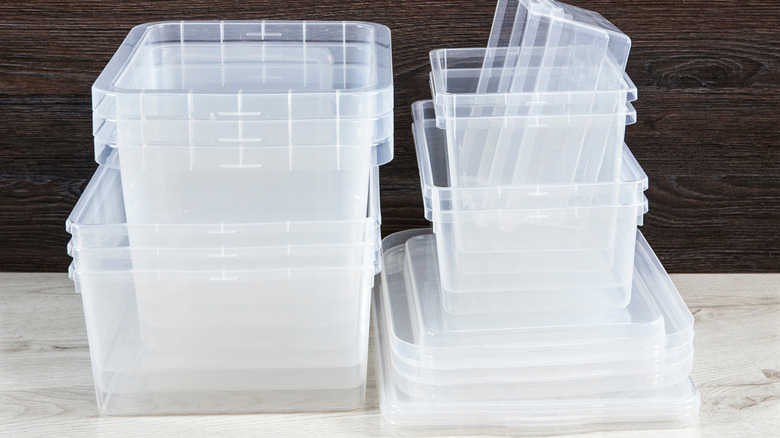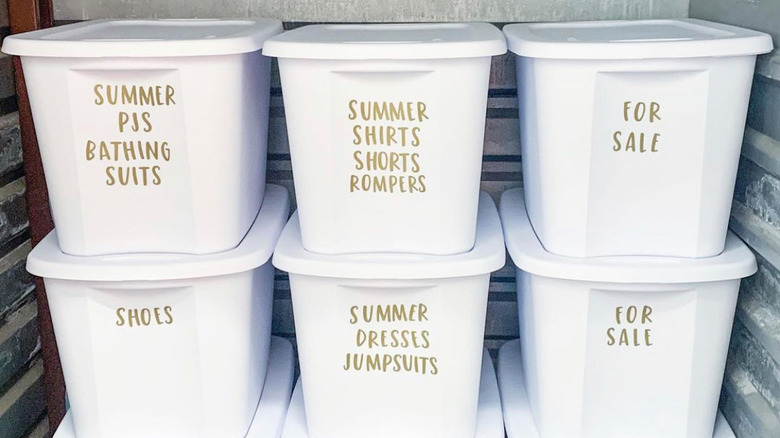How To Properly Fold And Store Summer Clothes For The Winter
When the end of summer is fast approaching, that is the time to strategize your seasonal closet swap. If you're not in the habit of routinely storing your off-season clothing, there are quite a few benefits to it. For example, say that you're consistently cramming things into your closet or dressers and, just as often, struggling to find what you need. According to The Container Store, stowing away the items that you won't reach for in the next six months maximizes the space you have for your current clothing. Just imagine how much more room there will be to store sweatpants or sweaters if a drawer of bathing suits is freed up.
In addition, per Organized Interiors, you'll be able to prolong the condition of your clothing if they're stored properly. Having shorts and dresses, for example, folded neatly and kept dust free over the winter months will preserve their state. This is simple to accomplish if you have a method to follow. That way, you can repeat the system in the future, ideally twice per year, especially if you live in an area that experiences all four seasons. The start of fall and the start of spring are the best times for this organization project.
From decluttering the things you won't need next year to properly folding the things you do want to keep and from the best bins to store things to labeling them, check out the following method to store summer clothes for the winter season.
1. Declutter first
Just like decluttering before a move prevents you from bringing the things that don't spark joy into your next home, doing so now keeps you from holding onto things for the next summer season. If you know, for example, that you did not wear a particular sundress at all this past summer and have little desire to wear it in the future, there's no reason to store it away and let it take up precious space for the next six months.
As A Bowl Full of Lemons points out, asking yourself certain questions as you sort through your stuff helps with the decision-making process. Honestly assess if you can see yourself ever wearing the item again or if it fits and flatters you. If the answer is a clear "no," then consider donating to a local charity or giving to someone you personally know who is in need. You can also ask an honest friend or relative to go through the closet with you and help you to pare down.
For any articles of clothing that have been damaged, such as stretched out and see-through bathing suit bottoms or t-shirts with stains beyond repair, they'll either have to be tossed or, in some cases, recycled. Earth911 indicates that some clothing retailers have recycle bins in their stores or, as they suggest, you can look up a way to recycle general fabric in your community.
2. Clean and prep
For the clothes that are staying with you into the next summer season, it's always advisable to wash them before storing them away. This ensures that your things are as clean and fresh as they can be going into a container for the next six months or so. Look carefully for and treat any stains beforehand because you may not be able to get them to come out later on. For delicate or tricky pieces, it's worth the trip to the dry cleaners for a professional's touch.
It's smart to also check for any repairs that need to be done. As Neat Little Nest suggests, pay attention to zippers or buttons that are broken so you can fix them, or have them fixed by a seamstress, now rather than later. While you most likely won't need to use a fabric shaver or depiller much for summer clothing, as opposed to winter sweaters, it's good to have a tool like this on hand in the off chance that you are putting away a bright-colored cardigan or wrap for the winter.
3. Decide on storage method
There are a few methods to store your clothes once they're ready. PODS Blog strongly suggests against using cardboard boxes, most especially in unfinished spaces, as bugs or rodents can easily make their way into them. Instead, opt for clear plastic bins with latched lids to keep anything from seeping in. Just be sure to keep them out of direct sunlight or use opaque containers so that the content's colors don't fade.
Another popular method is to use vacuum sealed bags as they significantly reduce the amount of space that clothing takes up. For added protection, you can opt to place flattened bags into a plastic bin as long as it's the right size. Moth Prevention points out that these types of bags shouldn't be used on all fabrics, specifically cashmere, leather, and silk. As for more durable fabrics, such as linen and cotton, you should opt to use these bags for shorter periods of time as all clothing needs room to breathe. When you remove them, give articles a quick shake and wash to have them feeling and smelling fresh again.
Lisa Trigstad explains, via Container Stories, that her favorite method to store seasonal clothing is by using fabric boxes with lids. This is an excellent way to store items on a high shelf in your closet, underneath your bed, or even in the guest room. Essentially, wherever there is some climate control since the lids are not sealed tight.
4. Fold correctly
If you're savvy with home organizing tricks, you might know that file folding your clothes can save a lot of space in dressers or even baskets. The same benefit can apply if you do the same with your clothes in storage. Whether they're in fabric bins or plastic totes, consider file folding the items as you would in a drawer and then stacking another layer on top to maximize the height. Since the summer clothes will be in there for an extended period of time, try to fold them as neatly as possible. If it's something that doesn't come naturally to you, a folding board might be all you need to effortlessly achieve the perfect crease.
Similar to packing a suitcase, you can also try to make the most use of space by rolling the articles of clothes. This can work well using a vacuum-sealed bag where file folding isn't an option. Moving.com explains that the military rolling method not only saves room in whatever container you're using to store or transport things in, but it also helps to reduce wrinkles over time.
Be careful not to roll or fold anything that can potentially be damaged. According to The Laundress, certain fabrics, such as delicate silk, should be hung. If you have any summer pieces that you want to take extra special care of, consider investing in hanging garment or vacuum-sealed bags, or even a small garment rack with a zippered enclosure to store off-season.
5. Label clearly
Just as important as it is to store your off-season clothes to preserve their condition and create space in your closet, it's also important to conspicuously label what is what. This way, when the next summer season rolls around, you can find what you have in a flash. Or, say you decide to go on an impromptu island vacation, you can access what you need without undoing your entire system.
It's best to keep like items together as you would when organizing your closet. This means storing all shorts near or with each other, all shirts, all swimsuits, and so on. Feel free to make a separate section with a small capsule summer wardrobe for the potential beach holiday so you can easily transfer everything to your suitcase.
According to The Organized Mama, the type of label you need to use will depend on the material of the container that it's in. Fabric bins, for example, will require either built-in label pouches, a bin clip, or a tag that is tied around the handle. You can tape a label to the outside of a vacuum-sealed bag or even place a list inside the bag itself with the contents facing forward. Plastic containers can withstand label or vinyl tape, but be aware that vinyl is harder to remove. One workaround is to label one side for your summer clothes and the opposite for winter, so you can simply flip the totes around twice per year.





